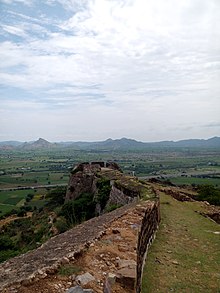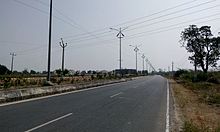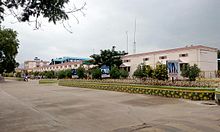Rayalseema


Rayalaseema
(Rāyalasīma) is a geographic region in the Indian state of Andhra Pradesh. It comprises four southern districts of the state namely, Anantapur, Chittoor, Kadapa and Kurnool.[2][3] As of 2011[update]census of India , the region with four districts had a population of 15,184,908 and covers an area of 67,526 km2 (26,072 sq mi).[4]
Contents
Etymology
The region was previously called Ceded districts during the rule of the British Raj. This is with reference to the time when the Nizam of Hyderabad, Ali Khan ceded the region to the British as a part of subsidiary alliance. Chilukuri Narayana Rao, a Telugu lecturer and activist from Anantapur deemed the term "ceded" as derogatory and coined the term Rayalaseema.[5] In the Andhra Mahasabha and Ceded Districts Conference held at Nandyala in November 1928, he moved a resolution to the effect which was accepted by the other delegates of the conference.
The name Rayalaseema hearkened back to the Vijayanagara times, whose Kings used a suffix Rāya (tadbhava of Sanskrit Rāja) or Rāyalu in Telugu as their title. The boundaries of Rayalaseema roughly match with the territorial extent of the Aravidu dynasty, the last dynasty to rule the Vijayanagara Empire.[5]
History
During the British era, the Nizam of Hyderabad ceded this area to the British, and hence was called Ceded Districts. Upon Independence, it was renamed as Rayalaseema as 'seema' was an administrative territorial entity of the Vijayanagara Empire similar to today's districts.[citation needed]
Post independence
The four districts of the region were part of the Madras Presidency until 1953.[6] From 1953 to 1956, the region was a part of Andhra State and in 1956, the Telangana region was merged with Andhra State to form Andhra Pradesh State.[7] On 2 February 1970, three taluks from Kurnool i.e., Markapur, Cumbum and Giddalur were merged along with some other taluks of Nellore district and Guntur district to form Prakasam district.
In February 2014, the Andhra Pradesh Reorganisation Act, 2014 bill was passed by the Parliament of India for the formation of Telangana state comprising ten districts. Hyderabad will remain as a joint capital for 10 years for both Andhra Pradesh and Telangana.[8] The new state of Telangana came into existence on 2 June 2014 after approval from the President of India.[9] The formation of a new state named Telangana from Andhra Pradesh is not considered an amendment to the Constitution of India per article 3 and 4 of that document.[10]
Geography
Rayalaseema region is located in the southern region of the state of Andhra Pradesh. The region borders the state of Tamil Nadu to the south, Karnataka to the west and Telangana to the north. Some areas in Coastal Andhra, such as Markapur revenue division, which share similar geography and climate to Rayalaseema.[11]
Religious destinations
Rayalaseema has many important places of pilgrimage. Tirumala Venkateswara Temple, abode of Lord Venkateswara is one of the richest and the most visited place of worship in the world.[citation needed] The other being Srisailam, Ahobilam, Srikalahasti, Kanipakam, Kadiri, Rayadurgam, Penna Ahobilam, Mahanandi, Mantralayam, Proddatur, Puttaparthi, Yaganti, Lepakshi, Vontimitta, Bramhamgarimatham, Pushpagiri etc. Shahi Jamia Masjid in Adoni is one of the oldest constructions in South India, built around 1662 AD by Siddi Masood Khan.[12]
Education
Universities
- Sri Venkateswara University
- Sri Krishna Devaraya University
- Yogi Vemana University
- Rayalaseema University
- Dr. Abdul Haq Urdu University
- Dravidian University
- Sri Padmavati Mahila Visvavidyalayam
- JNTU Anantapur
Medical colleges
- Rajiv Gandhi Institute of Medical Sciences, Kadapa
- Kurnool Medical College
- Government Medical College, Anantapur
Central institutions
- Indian Institute of Technology, Tirupati
- Indian Institute of Science Education and Research, Tirupati
- Indian Culinary Institute, Tirupati
- National Sanskrit University
- Indian Institute of Information Technology, Design and Manufacturing, Kurnool
- Central University of Andhra Pradesh
Deemed universities
Infrastructure
Roadways

The road network in region consists of many National Highways such as, NH 40, NH 42, NH 44, NH 140, NH 167, NH 340, NH 67, NH 69, NH 71, NH 716.

Railways

The rail connectivity is getting better with the projects allocated or being part of the region such as, Nandyal–Yerraguntla, Nadikudi–Srikalahasti, Kadapa–Bangalore sections are the under development projects which forms a part of the region.[13] Most of the region falls under the jurisdiction of Guntakal railway division of South Central Railway zone.
Airports


Rayalaseema region has air connectivity with four airports Tirupati International Airport, Sri Sathya Sai Airport, Kadapa Airport and Kurnool Airport.
Power

Rayalaseema Region has thermal as well solar power plants. Rayalaseema Thermal Power Station is located in Kadapa district and Andhra Pradesh government recently sanctioned solar power parks in Rayalaseema districts[14] with a capacity of 4000MW's.Today the state of Andhra Pradesh stood No.1 position in solar power generation with an installed capacity of 1868 MW[15] In India and also offers world's largest solar power park of 1000 MW is also located in Andhra Pradesh.
Politics
Neelam Sanjiva Reddy, Damodaram Sanjivayya, Kotla Vijaya Bhaskara Reddy, N. Chandrababu Naidu, Y. S. Rajasekhara Reddy, N.Kiran Kumar Reddy and Y. S. Jagan Mohan Reddy are the people who served as Chief Minister of Andhra Pradesh, hail from the Rayalaseema region of the state, with Y. S. Jagan Mohan Reddy being the incumbent. The region saw as many as 7 chief ministers for the state.[16]\
Factionalism
Rayalaseema is home to numerous factional families who are often intertwined with political parties and violently clash with each other. Government employees are known to dread postings in the region. The high crime rate is attributed to Rayalaseema's high poverty rate. Although violence has declined since the 1980s, factionalism still reigns supreme. Police records estimate that in the past 35 years, about 8,465 civilians have died as a result of factional violence. [17][18]
Sri Bagh act
Based on Sri Bagh act signed on 18 November 1937, Kurnool was made as the capital of the new state after the division of Andhra state from the Madras state.[19][20] As per the second State Resolution Commission, capital was shifted to Hyderabad upon the formation of Andhra Pradesh.[21]
See also
References
- "Andhra Pradesh Fact Sheet". mapsofindia.com.
- Jammanna, Akepogu; Sudhakar, Pasala (2016). Dalits' Struggle for Social Justice in Andhra Pradesh (1956–2008): From Relays to Vacuum Tubes. Cambridge Scholars Publishing. p. 156. ISBN978-1-4438-4496-3. Retrieved 12 July 2017 .
- Rajeev, M (11 October 2015). "Rayalaseema in a state of discontent". The Hindu. Archived from the original on 8 December 2015. Retrieved 8 December 2015.
- "Population of AP districts(2011)"(PDF) . ap.gov.in. p. 14. Archived from the original(PDF) on 12 November 2013. Retrieved 25 May 2014.
- Correspondent, Special. "The birth of Rayalaseema". The Hindu. Retrieved 12 June 2017.
- "The Indian Express - Google News Archive Search". The Indian Express – via Google News Archive Search.
- "The Indian Express - Google News Archive Search". The Indian Express – via Google News Archive Search.
- "The Andhra Pradesh Reorganisation Act, 2014"(PDF) . India Code Legislative Department. Ministry of Law and Justice. 1 March 2014. p. 2. Retrieved 14 July 2015.
- "Telangana state formation gazette". The New Indian Express. Retrieved 14 May 2014.
- "Constitution of India Sub-section". Indiankanoon.org. 4 March 2014. Retrieved 23 April 2014.
- "Andhra Pradesh – end of an era". Business Standard. Hyderabad. 30 July 2013. Retrieved 8 April 2016.
- "Archived copy". Archived from the original on 14 March 2011. Retrieved 2 April 2011.
- "Proper rail connectivity still a far cry in Rayalaseema". The Hindu. Retrieved 26 May 2017.
- "AP Solar Corpn sanctions 4,000 MW power parks". M.thehindubusinessline.com. 22 December 2015.
- Raghavendra, V. (29 April 2017). "With Kurnool solar park, State takes a giant leap". The Hindu. Retrieved 16 February 2019.
- "Telangana.com – Committed For Development". Telangana.com.
- "Factionalism, Violence and Politics in Andhra Pradesh's Rayalaseema". The Wire. Retrieved 1 August 2021.
- Mar 23, TNN /; 2019; Ist, 04:56. "Of the sordid theatre of faction killings in Rayalaseema region | Vijayawada News - Times of India". The Times of India. Retrieved 1 August 2021.
- Raju, P. Yenadi (2003). Rayalaseema during colonial times : a study un indian nationalism. New Delhi: Northern Book Centre. p. 214. ISBN978-81-7211-139-7. Retrieved 3 September 2015 .
- "APonline – History and Culture – History-Post-Independence Era". aponline.gov.in. Archived from the original on 20 December 2013.
- "Revive Sri Bagh pact, demands vedika". Hyderabad. 19 June 2014. Retrieved 3 September 2015.
Further reading
- Reddy, G. Samba Siva (2006–2007). "Making of Micro-Regional Identities in the Colonial Context: Studying the Rayalaseema Maha Sabha, 1934–1956". Proceedings of the Indian History Congress. 67: 500–513. JSTOR44147969 .
Media related to Rayalaseema at Wikimedia Commons